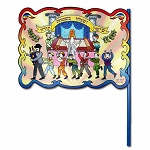Wave the Flag: The Flags of Simchat Torah

Simchat Torah is perhaps the happiest holiday of the Jewish High Holiday season. It's very name – which translates as "rejoicing with the Torah" – testifies to the happiness of the holiday, the joy of the completion of the annual cycle of weekly Torah readings and the beginning of a new annual cycle. Indeed, the sight of dancing and singing with the Sefer Torah (a Kosher Torah Scroll written by a scribe) during the holiday is a joyous one, especially for the children who join the dancing. Since children are too young to carry the Sefer Torah, they often carry special holiday flags, sometimes adorned with an apple at the top of the flag to symbolize the sweetness of Torah reading.
Though not as widely known as the Hanukkah Dreidel, the Simchat Torah flag has quite a long history as Jewish holiday gift for children. Records show that children have been dancing with flags during the holiday as early as the 17th century, and that the production of carefully-designed flags, ornamented with holiday symbols and verses from the Torah. Unfortunately, few of the historical flags survived – the earliest examples of Simchat Torah flags date back to the end of the 19th century (a special historical exhibition on the subject was held at the Eretz Israel Museum in 2011).
With the return of the Jews to their homeland and modern Israel's declaration of independence, the flags of Simchat Torah have received special meaning through new designs. Drawings of children in traditional European Jewish clothing were replaced with drawings of Israeli children in typical Israeli ("Tembel") hats, sometimes dancing outside the synagogue to symbolize the connection of Israeli children to the natural environment of the Holy Land. To make children curious about the holiday customs, the flag was often designed as a toy – notably with the possibility of opening the doors of the painted Torah ark on the flag.
As the young country faced struggles and achieved victories, paintings of IDF soldiers dancing also became common on Simchat Torah flags, as did paintings of the Western Wall (liberated by the IDF during the Six-Days War).
Simchat Torah flags remain popular to this very day, and they bring together different population groups in Israel: secular Jews often attend the Simchat Torah celebrations in synagogues, and secular children are seen waving the holiday flags alongside religious children, a true demonstration of sharing the joy that Torah brings.
Additional info about the Simchat Torah Flags (in Hebrew):

